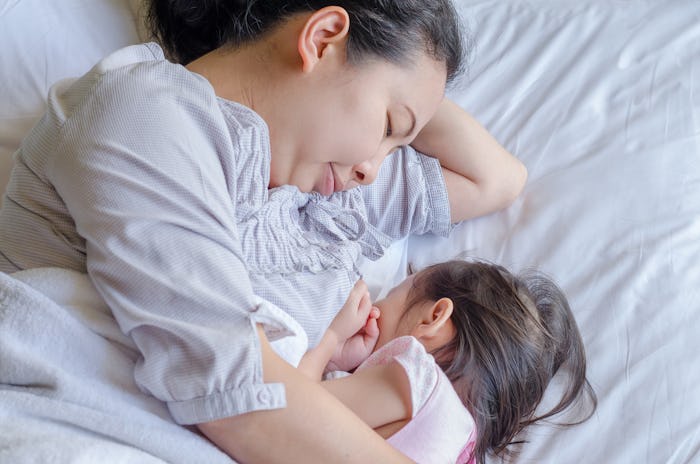Life

8 Breastsleeping Tips Lactation Consultants Want You To Know
If you're a new mom, you'd probably kill for a few extra minutes of sleep. Who am I kidding? Minutes are nowhere near enough to battle the sheer exhaustion that comes from weeks of interrupted sleep. Many breastfeeding moms have learned to cope with the night feedings by breastsleeping. If you are at your wit's end, and are thinking about bringing your baby into bed with you, there are some breastsleeping tips straight from a lactation consultant that can help keep your baby safe.
If you've never heard the term breastsleeping, it's simply a new name for something that breastfeeding moms have done since the beginning of time. Dr. James McKenna, director of the Mother-Baby Behavioral Sleep Laboratory, and Dr. Lee Gettler, director of the Hormones, Health, and Human Behavior Laboratory, both at the University of Notre Dame, coined the term "breastsleeping" in a peer-reviewed commentary piece in the journal Acta Paediatrica titled, "There Is No Such Thing As Infant Sleep, There Is No Such Thing As Breastfeeding, There Is Only Breastsleeping." Basically, breastsleeping is another way to say breastfeeding while bed-sharing. In thier piece, they argued that breastsleeping can be done safely, as long as parents apply the rules for bed-sharing.
Romper chatted with some International Board Certified Lactation Consultants who shared these tips for moms considering breastsleeping.
1Don't Second-Guess Your Motherly Instincts
You get a lot of advice when you become a mom, and one of the first things you may here isdon't bring the baby into the bed with you. But for many moms, breastsleeping feels instinctual. "Breastsleeping is a biologically normal sleep and feeding interaction that is critical for appropriate milk production and infant biorhythms," Danielle Downs Spradlin, a certified lactation counselor and the founder of Oasis Lactation Services, tells Romper. Babies are born new to breathing, eating, stooling, and gravity and must learn how to coordinate these activities. Spradline also suggests that breastsleeping can help them do that while reducing their stress.
"Infant stress is not like adult stress," she says. "In this sense, infant stress includes biological functions that are difficult like breathing, maintaining body temperature, and maintaining blood sugar. McKenna's research has shown that babies in skin to skin breastfeeding during sleep are protected from SIDS."
2Have A Firm Mattress
"Studies have found that bed-sharing with a breastfeeding baby and parent is safe as long as certain requirements are met– these include making sure the adult mattress is firm," Rachel O'Brien, certified lactation consultant, tells Romper. So how do you know what mattress is OK? According to Kids Health From Nemours, soft mattresses, including those with memory foam or waterbeds, can increase your baby's risk for suffocation. Ask Dr. Sears recommended a queen or king-size bed if you are bed-sharing so that both the parents and the baby will have plenty of room to roll over safely.
3Don't Smoke
Even if you never smoke in your baby's presence, O'Brien does not recommend that smokers bed-share with their baby. When you sleep next your baby, Ask Dr. Sears noted that your baby inhales pollutants that stick to your body such as benzene, ammonia, hydrogen cyanide, formaldehyde, and nicotine. Babies of parents who smoke are also at an increased risk of Sudden Infant Death Syndrome (SIDS), according to the Centers For Disease Control And Prevention (CDC).
4Don't Take Substances That Make You Drowsy
If you are taking any medications or substances that make you sleepy, O'Brien does not recommend breastsleeping. Pediatrician Dr. Sydney Spiesel warned listeners of NPR that even over the counter medications such as antihistamines can cause a parent to sleep too deeply, putting their baby at risk for suffocation. Always sleep in separate beds if you are taking a medication that can cause drowsiness.
5Breastfeed In A Safe Space
"It's important for all parents to have a safe breastsleeping space and plan even if they don't plan to bed-share or co-sleep because nearly every parent will fall asleep feeding baby at some point," Kristin Gourley, certified lactation consultant, tells Romper.
Because a lot of moms breastfeed in bed, O'Brien recommended the Safe Sleep Seven guide on La Leche League International's (LLLI) website which stated that in order to make your bed a safe sleeping surface, it should only have your pillow, the bottom sheet, top sheet, and a light duvet or blanket. No heavy quilts, comforters, or excess pillows.
6Don't Swaddle Your Baby
LLLI's Safe Sleep Seven guide also noted that babies who bed-share should not be swaddled. According to Kelly Mom, a swaddled baby may overheat, and can not effectively move covers from their face or use their arms and legs to alert a parent who gets too close.
7Don't Allow Siblings Or Pets In The Bed
Keeping pets and other children out of the bed is another way to keep your sleeping surface safe, according to our experts. Kelly Mom warned that you should never allow an older sibling or other child to bed-share with a baby who is under one year of age. Children can thrash around in their sleep and put the baby at risk for suffocation or strangulation. Parents magazine noted that not only do pets in the bed increase your baby's risk of suffocation or other injury, floating fur or dander could impair your child's breathing.
8Keep Babies Sleeping On Their Backs
According to the American Academy of Pediatrics (AAP), when they are not nursing, babies should sleep on their backs. This is also part of LLLI's Safe Sleep Seven guide to creating a safe sleep space for your bed-sharing baby. Back sleeping also reduces your baby's risk of SIDS.